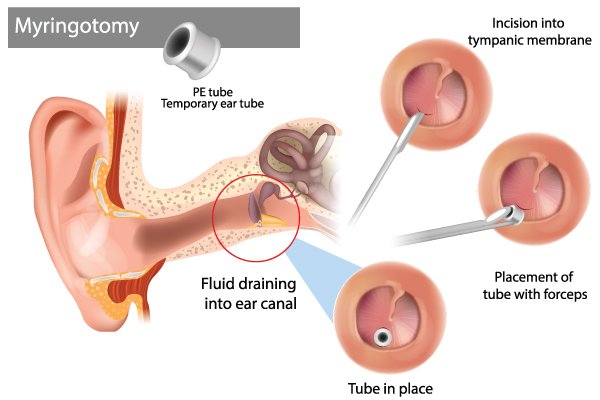Ear Tubes for Kids in Atlanta, GA
Young children experience more ear infections than adults because the main ventilation tube for the air pocket under the eardrum (the eustachian tube) is immature, and predisposes them to develop ear infections instead of preventing them. The eustachian tube connects the ear to the back of the nose and is what “pops” when you yawn, sneeze, fly, etc.
Ear infections also create thick fluid under the eardrum as well, and this is what muffles hearing and sets the stage for further infections. Antibiotics may clear the infection, but may not be enough to resolve the fluid trapped under the eardrum. This is why some children have chronic ear infections despite numerous antibiotics. For persistent issues, ear tubes for kids in Atlanta may be recommended to help drain the fluid and prevent future infections. For persistent issues, ear tubes for kids in Atlanta may be recommended to help drain the fluid and prevent future infections.
What are Ear Tubes?
Ear tubes (i.e. tympanostomy tubes or myringotomy tubes) are small pieces of plastic or metal that are placed through the eardrum to ventilate the space underneath. They prevent fluid from building up under the eardrum and provide better long-term control of ear infections than antibiotics alone.
Tubes are placed for frequent and persistent ear infections that do not respond to antibiotics. The risk of ear infections drops significantly after tympanostomy tubes are placed. Persistent fluid in the ear that muffles hearing or causes speech delay in children is also effectively treated with tympanostomy tubes.
Tympanostomy tubes last 1-2 years, and then fall out on their own. The chances of falling “in” under the eardrum are very low. Scarring of the eardrum is usually minimal and does not affect hearing. The chances of needing a second set of tympanostomy tubes are less than 20%. Children typically do not feel the tubes while they are in place and cannot reach them.
Ear drainage with tubes is uncommon, and its appearance usually means an ear infection is present. Pain, fever, and irritability are usually not seen with ear infections with tympanostomy tubes. Antibiotic ear drops are often all that is required to control ear drainage.
Choosing Between Surgical and In-Office Ear Tube Placement
Ear tube placement may occur in the operating room or in the office setting, depending on several factors (diagnosis, parental choice, and finances). For those with insurance, surgery may be covered. Most Humingbird® procedures are not covered by insurance; however, we are happy to provide a good-faith estimate of costs.
Surgery: Securing a surgery schedule at the local hospital may involve a waiting period. Once the surgery date has been obtained, the patient receives anesthesia (usually by mask), and surgical tympanostomy is performed. Most children are ready to go home 15 minutes after the procedure is complete. By the end of the day, most patients are fully recovered. While activity is not restricted after tympanostomy tube placement, earplugs or swimming plugs are recommended with exposure to untreated water (lake, river, ocean, etc). For families considering ear tubes for kids in Atlanta, it’s important to discuss these options and any concerns with the healthcare provider.
In-Office: Penta is among the first in the U.S. to offer parents an alternative to traditional ear tube surgery. This new approach uses the FDA-cleared Hummingbird® device. It eliminates the need for general anesthesia and moves this common procedure to the comfort of the office. Parents may be present in the room, which often makes the process less stressful and brings comfort to the child.
The Penta ENT Surgeon will carefully apply a topical anesthetic to numb the eardrum and use the proprietary Hummingbird device to safely place the ear tubes in a single pass. In total, the process is typically performed in under 5 minutes, and your child may return to normal activities immediately after the procedure.
To Conclude
If your child is experiencing ear infections or needs specialized ENT care, our expert children’s ENT in Atlanta are here to help. With advanced treatments and compassionate care, we ensure your child’s health and comfort. Contact us today to schedule a consultation with a leading pediatric ENT specialist in Atlanta.


